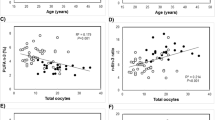Abstract
Purpose: Our purpose was to evaluate the L-ascorbate level in human preovulatory follicular fluid and to quantify the blood/follicle gradient for vitamin C. The effect of smoking on the follicular L-ascorbate concentration was studied. The correlations were tested between follicular L-ascorbate and follicle size and oocyte maturity.
Methods: In 65 women undergoing in vitro fertilization, samples of follicular fluid and blood serum were collected. Biochemical analyses included L-ascorbate determinations by a colorimetric method and cotinine measurements by a radioimmunoassay.
Results: The average follicular fluid:serum ratio for L-ascorbate was 1:68. Ascorbate levels in follicular fluid and serum were significantly correlated. The follicular L-ascorbate level did not correlate with the follicle size and the oocyte maturity grade. Insignificantly lowered follicular L-ascorbate levels were observed in smokers.
Conclusions: The extracellular compartment of the Graafian follicle is a site of an ascorbate accumulation. Exposure to tobacco smoke does not significantly diminish the intrafollicular pool of L-ascorbate.
Similar content being viewed by others
REFERENCES
Nishikimi M, Yagi K: Molecular basis for the deficiency in humans of gulonolactone oxidase, a key enzyme for ascorbic acid biosynthesis. Am J Clin Nutr 1991;54:1203S–1208S
Millar J: Vitamin C—the primate fertility factor? Med Hypotheses 1992;38:292–295
Edwards R: Follicular fluid. J Reprod Fertil 1974;37:189–219
Luck M, Jeyaseelan I, Scholes A: Ascorbic acid and fertility. Biol Reprod 1995;52:262–266
Jackson K, Nurredin A, Clarke R, Hornstein M, Friedman A: The appearance of one-pronuclear human oocytes is associated with a better ovulation-induction response and successful pregnancy outcome. Fertil Steril 1992;58:366–377
Veek L: Atlas of the Human Oocyte and Early Conceptus. Baltimore, Williams and Wilkins, 1986
Pojer R: Carboxyhemoglobin, cotinine and thiocyanate assay compared for distinguishing smokers from non-smokers. Clin Chem 1984;30:1377–1380
Zenses MT, Reed TE, Wang P, Klein J: Cotinine, a major metabolite of nicotine, is detectable in follicular fluids of passive smokers in in vitro fertilization therapy. Fertil Steril 1996;66:614–619
Sterzik K, Stehler E, De Santo M, Trumpp N, Abt M, Rosenbush B, Schneider A: Influence of smoking on fertility in women attending an in vitro fertilization program. Fertil Steril 1996;65:810–814
Davis MB, Austin J, Partridge DA: Vitamin C: Its Chemistry and Biochemistry. Cambridge, Royal Society of Chemistry, 1991
Basu J, Mikhail H, Payrandeau P, Palan P, Romney S: Smoking and the antioxidant ascorbic acid: plasma, leukocyte, and cervicovaginal cell concentration in normal healthy women. Am J Obstet Gynecol 1990;163:1948–1952
Washko P, Wang Y, Levine M: Ascorbic acid recycling in human neutrophils. J Biol Chem 1993;268:15531–15535
Espey L: Ovulation as an inflammatory reaction—A hypothesis. Biol Reprod 1980;22:73–106
Hulmes D: The collagen superfamily-diverse structures and assemblies. Essays Biochem 1992;27:49–67
Himeno N, Kawamura N, Okamura H, Mori T, Fukomoto M, Midirikawa O: Collagen synthetic activity in rabbit ovary during ovulation and its blockade by indomethacin. Acta Obstet Gynecol Jpn 1984;36:1930–1934
Kramer M, Harman M, Brill A: Disturbances of reproduction and ovarian changes in the guinea-pig in relation to vitamin C deficiency. Am J Physiol 1993;106:611–622
Kao J, Huey G, Kao R, Stern R: Ascorbic acid stimulates production of glycosaminoglycans in cultured fibroblasts. Exp Mol Pathol 1990;53:1–10
Franchimont P, Hazee-Hagelstein MT, Hazout A, Gysen P, Salat-Barboux J, Schatz B, Demerle F: Correlation between follicular fluid content and the results of in vitro fertilization and embryo transfer. III. Proteoglycans. Biol Reprod 1990;43:183–190
Goralczyk R, Moser U, Matter U, Weiser H: Regulation of steroid hormone metabolism requires L-ascorbic acid. Ann NY Aced Sci 1992;669:349–351
Halliwell B, Gutteridge JM: The antioxidants of human extracellular fluids. Arch Biochem Biophys 1990;280:1–8
Paszkowski T, Clarke RN: Generation of reactive oxygen species by human preovulatory granulosa cells. Ginekol Pol 1996;67 (Suppl 6) 99–107
Paszkowski T, Traub AI, Robinson SY, McMaster D: Selenium dependent glutathione peroxidase activity in human follicular fluid. Clin Chim Acta 1995;236:173–180
Author information
Authors and Affiliations
Rights and permissions
About this article
Cite this article
Paszkowski, T., Clarke, R.N. The Graafian Follicle Is a Site of L-Ascorbate Accumulation. J Assist Reprod Genet 16, 41–45 (1999). https://doi.org/10.1023/A:1022597629622
Issue Date:
DOI: https://doi.org/10.1023/A:1022597629622




